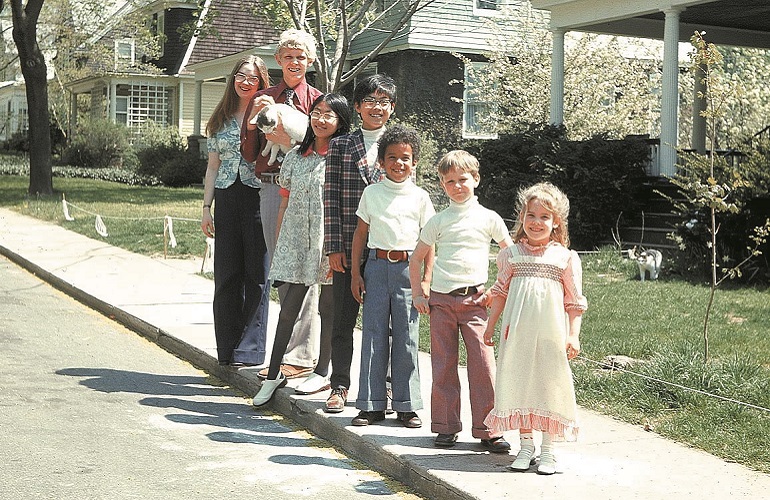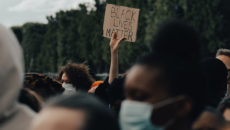Looking Back: Where Do I Belong?
A black filmmaker raised in a multiracial family explores the complexities of identity. Growing up black with white parents, in a predominantly white suburb during the 1970s, Phil Bertelsen experienced transracial adoption firsthand.
He says, “On a personal level, I recognized my adoptive family as the people I love and trust most in the world. Yet growing up, many made me feel I was out of place in the back of the family station wagon.” Having no contact with a black community left him with burning questions about his place in the world outside his family: “I found myself wondering which factors—physical, emotional, historical, social—determine where I belong.”
Outside Looking In traces his ongoing exploration of these issues, as well as the story of his sister, Aline, and her two sons adopted transracially a decade ago. The film also follows Walt and Ellen, a white Midwestern couple currently in the process of adopting, as they meet Diane, an African-American woman placing her son for adoption.
[Expert Audio: Inside Transracial Adoption]
With these three narrative threads, the film weaves a 30-year history of transracial adoption in America. Phil talked to us about Outside Looking In and what he hopes it offers people touched by transracial adoption.
AF: When and why did you decide to make this documentary?
PB: I’ve been thinking about it for as long as I’ve been involved in media. But what pushed me into action was the Multiethnic Placement Act, which essentially prohibits race from being a factor in adoption. I don’t think race should be a prohibiting factor to the extent that it once was, when black children were held in foster care indefinitely while attempts were made to locate a black family.
I’m not a strict “same-race placement” advocate. But I do think that there’s a problem with a law that doesn’t allow race to be a part of the dialogue. Families should at least be probed as to what their relationship—their community’s relationship, their family’s relationship—is with a child’s culture of origin. I wanted to promote dialogue.
AF: When did you begin to connect with African-American culture as we see you trying to help your nephew connect in the film?
PB: When I got to college, I immersed myself in a culture I hadn’t been exposed to—black culture. I asked for a black roommate, and I got someone from the Bronx, which couldn’t have been further from my suburban high school experience.
It wasn’t easy going entirely, but I learned quickly that two worlds coexist: one black and one white. I was surprised by that—startled and amazed and rudely awakened. From that point on, I made a concerted effort to find out what I’d been missing.
[How Will We Teach Our Child About Her Culture?]
AF: How did you come to seek out the foster family who raised you from age 16 months to four-and-a-half years, which we see played out in this film?
PB: By four-and-a-half, when I was adopted, a child’s formed a certain identity—and I was wondering who that person was who got me there. So I went and found her with the help of social workers who have long been aware of my many inquiries.
It boggles my mind that I can’t remember much of my life with them—four years. I think it has something to do with being that age and being removed from what’s familiar. You kind of shut the door in an effort to feel permanent somewhere.
AF: At one point your mother says that she and your father didn’t have access to all the support groups and information sources that adoptive parents have access to today—
PB: “—and whatever your gut told you, you did.” That’s my mom! If I can say I have an ounce of that kind of steely resolve and determination to trust my instincts, I’m having a good day.
AF: How do you think things might have been different if your family had had access to all of those resources?
PB: I think we would have lived a little differently. I’m not sure we would have changed towns, but we probably would have lived in a different part of town. We might have gone to a different church.
It’s not like my parents were oblivious to these kinds of things—I think the conversation was in the wind—but it wasn’t central, and it didn’t have any real credibility because there was no empirical data or experience leading up to it. It was all just theory. We were kind of making our own map.
AF: How do you see this film fitting into the larger picture of your generation speaking out about your experiences of transracial adoption?
[The Hunt for Diversity in Small Town America]
PB: I hope that it can be used as a tool, by agencies and organizations, lawyers and adoption workers, who want to prepare parents for what it is they’re getting themselves into. It’s pleasure and pain. It’s talking and silence. It’s a mix of all these things, and to think that it’s going to be one without the other is just misrepresenting the experience. I hope the film demonstrates that.



